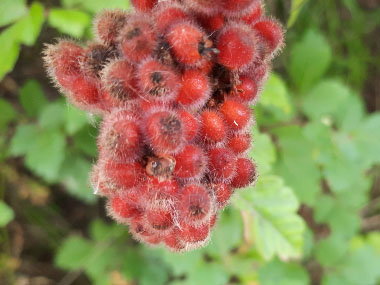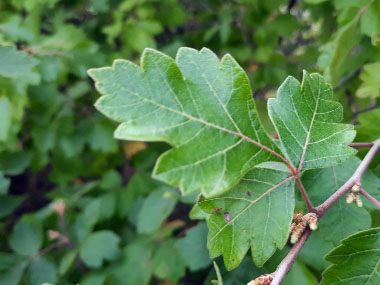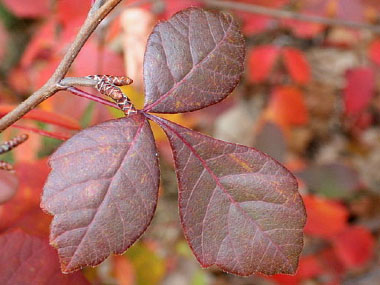






To support our efforts please browse our store (books with medicinal info, etc.).
Fragrant Sumac is a native, medium-sized shrub that grows in the wild and is often used in landscaping. It has many attractive features such as the rich red leaves in the autumn, and red berries that look somewhat similar to staghorn sumac. This sumac is a dense, low-growing, rambling shrub which spreads by root suckers to form thickets in the wild. This shrub was used by many indiginous people. The Natchez used the root to treat boils. The Ojibwa took a decoction of fragrant sumac root to stop diarrhea. The leaves of fragrant and staghorn sumac were mixed with tobacco and smoked by many tribes of the plains region. They tend to grow close together forming dense thickets. Fragrant sumac is in the Cashew Family (Anacardiaceae). Although native to the U.S. and Canada, this shrub also grows in some European countries.
Trunk/Bark
Young bark can be covered with dense fine hair and a few small raised lenticels. The bark of a mature shrub is thin and smooth. When mature, it peels off easily.
Branches/Twigs
They are brownish-gray, with rust-colored lenticels when young. Older twigs and stems are brown.
Height
Fragrant sumac grows to about 2 metres (6') tall and can be just as wide.
Leaves/Needles
Leaves are alternate, compound (3 leaflets), and toothed. Leaves (and twigs) are fragrant when rubbed or crushed. Medium green leaves turn to attractive shades of orange, red and purple in autumn. The leaves resemble in appearance those of the poison ivy (Rhus radicans). There is one leaf per node along the stem.
Flowers
Tiny yellow flowers bloom at the twig tips in early spring before the foliage. Separate male flowers (in catkins) and female flowers (in clusters) appear on the same plants (monoecious) or, more commonly, on different plants (dioecious). Male catkins form in late summer and persist throughout the winter until eventually blooming in spring. Female flowers give way in late summer to small clusters of fruit. Individual flowers are very small, bright yellow with a bell shaped hypanthium. Each flower has 5 spatula-shaped petals that have rounded tips, a light greenish-yellow calyx with 5 pointed lobes.
Fruit
The round, red, fleshy, and hairy fruits are small. They grow between 3.5 and 4.5mm (1/8 to 3/16") in diameter when they ripen in August and September. These berries may persist into winter.
Habitat
This shrub grows in the contiguous U.S., and throughout southern Canada. These shrubs like open, sunny, moist habitats such as upland prairies, pastures, meadows, edges of woodlands, along fences, roads, and along stream banks. It tolerates full sun and light shade. It thrives in well-drained areas, such as along a slope. This shrub is drought tolerant.
Edible Parts
Fruit can be used raw or cooked. The fruit is small, and like staghorn sumac, can be infused in cold water to make a citrusy-flavored beverage. The fruit can be dried and ground into a powder.
Other Name
Lemon Sumac.
Recipes
Winter Survival Food Handbook

PDF Plant Magazines
Types of Wild Food
Geographic Zones Seasons
Disclaimer
EdibleWildFood.com is informational in nature. While we strive to be 100% accurate, it is solely up to the reader to ensure proper plant identification. Some wild plants are poisonous or can have serious adverse health effects.
We are not health professionals, medical doctors, nor are we nutritionists. It is up to the reader to verify nutritional information and health benefits with qualified professionals for all edible plants listed in this web site. Please click here for more information.
Why Edible Wild Food?
- Food costs are rising
- Free, wild food is readily abundant
- Wild food adds nutrition to your diet
- Wild food can help treat various medical conditions





